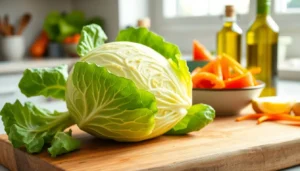Table of Contents
ToggleIn a world where culinary masterpieces often require a PhD in gastronomy, minimal ingredient meals are the unsung heroes of the kitchen. Who says you need a pantry full of exotic spices and a degree in molecular gastronomy to whip up something delicious? Sometimes, less really is more, and with just a handful of ingredients, anyone can create meals that are simple yet satisfying.
Overview Of Minimal Ingredient Meals
Minimal ingredient meals prioritize simplicity without sacrificing flavor. Fewer components can enhance creativity in the kitchen. Many home cooks find joy in experimenting with limited pantry items.
Categories of minimal ingredient meals include one-pot dishes, simple salads, and quick stir-fries. Each type showcases how basic ingredients can produce satisfying results. Starting with fresh produce and pantry staples helps in creating these meals.
Utilizing herbs and spices elevates the taste of minimal ingredient dishes. When someone incorporates garlic, olive oil, or lemon juice, the meal transforms into something vibrant. Ingredient pairings often prove crucial for maximum flavor impact.
Meal prep becomes more straightforward with fewer ingredients. With minimal shopping and prep time, cooks gain efficiency. Resources such as cooking blogs and social media platforms offer inspiration for easy recipes.
Nutrition remains important when focusing on minimal ingredients. Choices often emphasize whole, unprocessed foods. Balanced meals can achieve adequate protein, healthy fats, and carbohydrates, despite the limited number of items.
Finally, cost-effectiveness plays a significant role in meals with fewer ingredients. Savings accumulate over time when someone relies on basic items rather than elaborate recipes. Home cooks discover a world of possibilities by embracing minimalism in the kitchen.
Benefits Of Minimal Ingredient Meals
Minimal ingredient meals offer a range of advantages, making cooking more accessible and enjoyable.
Simplicity And Convenience
Simplicity in meal preparation makes cooking a less daunting task. Limited ingredients reduce the complexity of recipes, allowing cooks to focus on flavor rather than technical skills. Convenience stands out, as fewer items lead to quicker shopping and preparation times. One-pot meals and quick stir-fries exemplify how simple combinations can create satisfying outcomes. Fresh produce and pantry staples become key players in these recipes, enabling creativity without the need for extensive planning. Ease of access to recipes online inspires home cooks to experiment with what they already have on hand. Cooking doesn’t have to be time-consuming or elaborate, and minimal meals emphasize this principle.
Nutritional Considerations
Nutritional value often remains high in minimal ingredient meals. Whole, unprocessed foods typically feature, providing essential nutrients without excess additives. This focus on quality ingredients ensures balanced meals for better health outcomes. Limited ingredient lists can help individuals avoid hidden sugars and unhealthy fats present in more complex recipes. Small quantities of herbs and spices elevate flavors while keeping meals wholesome. Preparing meals with fewer, quality items encourages healthier eating habits. Staying aware of what goes into each dish also promotes mindful cooking, emphasizing health-focused choices in daily diets.
Popular Minimal Ingredient Meals
Minimal ingredient meals can be both satisfying and uncomplicated. Here are some options for different times of the day.
Breakfast Options
Oatmeal offers a simple, nutritious start to the day. With just oats and water, cooks can create a filling meal. Adding fresh fruits or honey enhances flavor. Smoothies require few ingredients; a banana, spinach, and yogurt blend seamlessly for a refreshing morning drink. Scrambled eggs, made with only eggs and a splash of milk, provide protein in minutes. Toast with avocado adds a creamy texture without complexity.
Lunch Ideas
Salads can be made with a base of mixed greens and a simple vinaigrette. Adding nuts or seeds introduces texture and healthy fats. Grain bowls also thrive on minimal ingredients; quinoa, beans, and seasonal vegetables combine for a wholesome dish. Wraps create a portable option, requiring just a tortilla, protein, and one or two veggies. Pasta with olive oil and garlic showcases the power of few flavors in a satisfying meal.
Dinner Recipes
Stir-fries utilize just a few vegetables and a protein of choice. Tossing these in a hot skillet with soy sauce creates a quick dinner. One-pot rice dishes simplify cleanup, combining rice, broth, and vegetables into a flavorful, easy entry. Sheet pan meals require arranging chicken or fish with seasonal veggies, roasting them together. Finally, soups can come together from broth, a protein, and any available vegetables, resulting in a comforting dish with minimal fuss.
Tips For Creating Minimal Ingredient Meals
Creating minimal ingredient meals allows home cooks to discover the beauty of simplicity. By focusing on key elements, anyone can prepare satisfying dishes with ease.
Ingredient Substitutions
Ingredient substitutions enable flexibility in meal prep. When a particular item isn’t available, alternatives exist. Substitute Greek yogurt for sour cream in dressings or use chickpeas instead of meat for added protein. Consider frozen vegetables if fresh produce isn’t accessible. Substituting spices can also enhance flavors, such as using smoked paprika for a hint of smokiness. Most recipes accommodate minor adjustments, so creativity thrives in the kitchen.
Meal Prep Strategies
Meal prep strategies streamline the cooking process for minimal ingredient meals. Starting with a plan simplifies grocery shopping, focusing on key essentials. Pre-chopping vegetables or cooking grains in bulk saves time during busy weekdays. Utilizing versatile ingredients, such as grains or legumes, allows incorporation into various dishes. Grouping similar meals can further enhance efficiency, enabling quick assembly during busy times. By organizing the kitchen, anyone can maximize space and easily access necessary items.
Embracing minimal ingredient meals transforms the cooking experience into something enjoyable and stress-free. This approach not only enhances creativity but also promotes healthier eating habits by focusing on whole foods. With fewer ingredients to manage, meal prep becomes quicker and more efficient, allowing for a greater emphasis on flavor and quality.
By exploring the versatility of basic ingredients and experimenting with simple recipes, home cooks can discover a world of satisfying meals that don’t require extensive skills or resources. The journey into minimalism in the kitchen opens up endless possibilities for delicious and nutritious dining.




